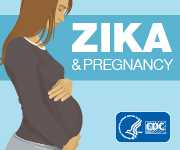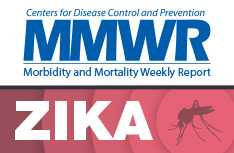US Zika Pregnancy Registry
Summary
To understand more about Zika virus infection, CDC established the US Zika Pregnancy Registry and is collaborating with state, tribal, local, and territorial health departments to collect information about pregnancy and infant outcomes following laboratory evidence of Zika virus infection during pregnancy. The data collected through this registry will be used to update recommendations for clinical care, to plan for services for pregnant women and families affected by Zika virus, and to improve prevention of Zika virus infection during pregnancy.
If you are a healthcare provider or health department and you have questions about the registry, please email ZikaMCH@cdc.gov.
Eligibility for the Registry
- Pregnant women and infants who meet the following criteria are eligible for the US Zika Pregnancy Registry: Pregnant women in the United States* with laboratory evidence of Zika virus infection (positive or equivocal test results, regardless of whether they have symptoms) and periconceptionally, prenatally or perinatally exposed infants born to these women.
- Infants with laboratory evidence of congenital Zika virus infection (positive or equivocal test results, regardless of whether they have symptoms) and their mothers.
*Includes the 50 US states, the District of Columbia, and the following jurisdictions: American Samoa, Federated States of Micronesia, Guam, Northern Mariana Islands, and Republic of the Marshall Islands, Republic of Palau, and US Virgin Islands. Pregnant women in Puerto Rico are excluded from the Registry and are followed by the Zika Active Pregnancy Surveillance System (ZAPSS), a similar system specifically tailored to Puerto Rico.
Health Departments: How to Participate
State, tribal, local, and territorial health departments can participate in the US Zika Pregnancy Registry. They can
- Identify pregnant women and infants eligible for Zika virus testing in accordance with state or CDC guidelines.
- Coordinate testing at a state public health laboratory or CDC for those eligible.
- Report information about pregnant women in the United States with laboratory evidence of Zika virus infection (positive or equivocal test results, regardless of whether they have symptoms) and information about periconceptionally, prenatally or perinatally exposed infants born to these women, including infants with congenital Zika virus infection
- Collect enhanced surveillance data about pregnant women and their infants who are eligible for the Registry.
- Work with CDC to determine state-specific methods for collecting and sharing data.
Healthcare Providers: How to Participate
CDC and state, tribal, local, and territorial health departments request that healthcare providers participate in the US Zika Pregnancy Registry.
Obstetric healthcare providers can:
- Report information about pregnant women with laboratory evidence of Zika virus to their state, tribal, local, or territorial health department.
- Collect pertinent clinical information about pregnant women and their infants on the Pregnancy and Zika Virus Disease Surveillance forms.
- Provide the information to state, tribal, local or territorial health departments or directly to CDC registry staff if asked to do so by local health officials.
- Notify state, tribal, local, or territorial health department staff or CDC registry staff of adverse events (e.g., spontaneous abortion, termination of pregnancy).
Pediatric healthcare providers can:
- Identify and report suspected congenital Zika virus exposure to their state, tribal, local, or territorial health department for possible testing.
- Collect pertinent clinical information about infants born to women with laboratory evidence of Zika virus infection or infants with congenital Zika virus infection.
- Provide the information to state, tribal, local or territorial health departments or directly to CDC registry staff if asked to do so by local health officials.
- Notify state, tribal, local, or territorial health department staff or CDC registry staff of adverse events (e.g., perinatal or infant deaths).
Healthcare providers practicing in Puerto Rico should report information to the Puerto Rico Zika Active Pregnancy Surveillance System (ZAPSS) rather than to the US Zika Pregnancy Registry.
Lab Evidence of Possible Exposure to Zika Virus
Laboratory evidence of possible Zika virus infection for the US Zika Pregnancy Registry is defined as
- Recent Zika virus infection detected by Zika RNA nucleic acid test (NAT) (e.g., real-time reverse transcription polymerase chain reaction [rRT-PCR]):
- Zika virus RNA detected by NAT on any maternal or fetal/infant clinical specimen (e.g., serum, urine, whole blood, cerebrospinal fluid, amniotic fluid, cord blood, saliva, placenta, umbilical cord tissue, placental membranes, or fetal tissue
- Recent Zika virus infection or recent flavivirus infection detected by serologic tests of maternal or infant serum or cerebrospinal fluid
- Zika virus IgM positive or equivocal AND Zika virus plaque reduction neutralization test (PRNT) titer ≥10, (regardless of dengue virus PRNT value) OR
- Zika virus IgM positive or equivocal AND Zika virus PRNT not performed in following state, tribal, local, or territorial health department protocol, OR
- Zika virus IgM negative AND dengue virus IgM positive or equivocal AND Zika virus PRNT titer ≥10 (regardless of dengue virus PRNT titer)
- These inclusion criteria are intentionally broad because of the known cross-reactivity in IgM testing and inability to distinguish between Zika and dengue virus through the use of PRNT.
- If maternal Zika virus IgM and dengue virus IgM are both negative, and maternal PRNT was performed per jurisdictional protocol with Zika virus PRNT titer ≥10, additional testing is needed to meet inclusion criteria. For example, if maternal testing is performed >12 weeks from possible Zika virus exposure and maternal IgM testing is negative with Zika virus PRNT titer ≥10, the mother-infant pair would be included if the infant had Zika virus IgM positive or equivocal, Zika virus RNA or antigen detected, or Zika virus cultured.
- Zika virus infection confirmed by other tests in any maternal or fetal/infant clinical specimen (e.g., serum, urine, whole blood, cerebrospinal fluid, amniotic fluid, cord blood, saliva, placenta, umbilical cord tissue, placental membranes, or fetal tissue)
- Culture of Zika virus
- Detection of Zika virus antigen
*Reviewed and updated on an ongoing basis
Related Resources
US Zika Pregnancy Registry: How to Participate
Margaret Lampe, RN, MPH, a nurse scientist with the Pregnancy and Birth Defects Task Force for CDC’s 2016 Zika virus response shares an overview of the US Zika Pregnancy Registry and how to participate.
Healthcare Provider Toolkit for Health Departments
How to Participate
Pediatric Healthcare Providers:
Tribal Healthcare Providers:
- Page last reviewed: October 3, 2017
- Page last updated: October 3, 2017
- Content source:





 ShareCompartir
ShareCompartir
